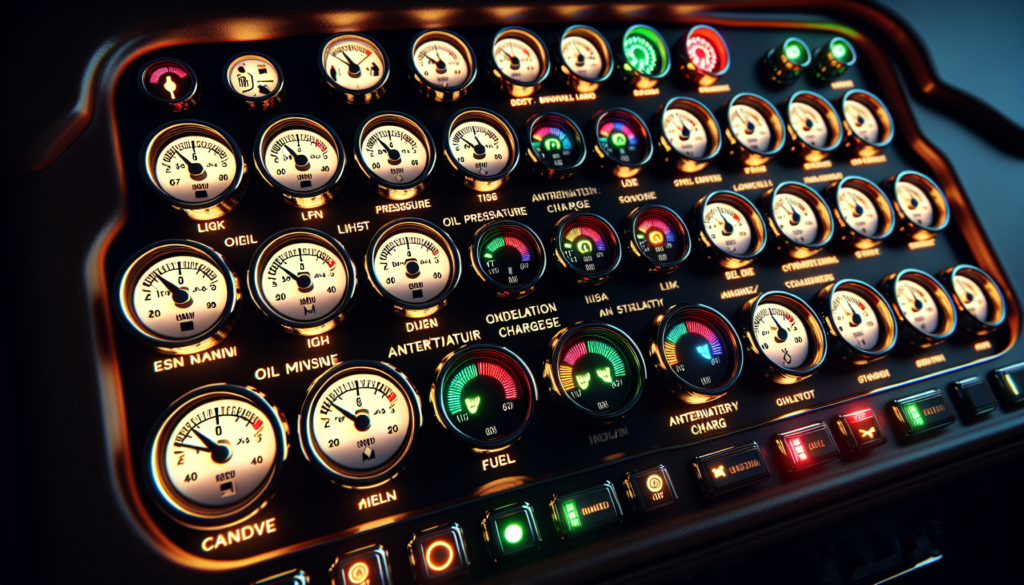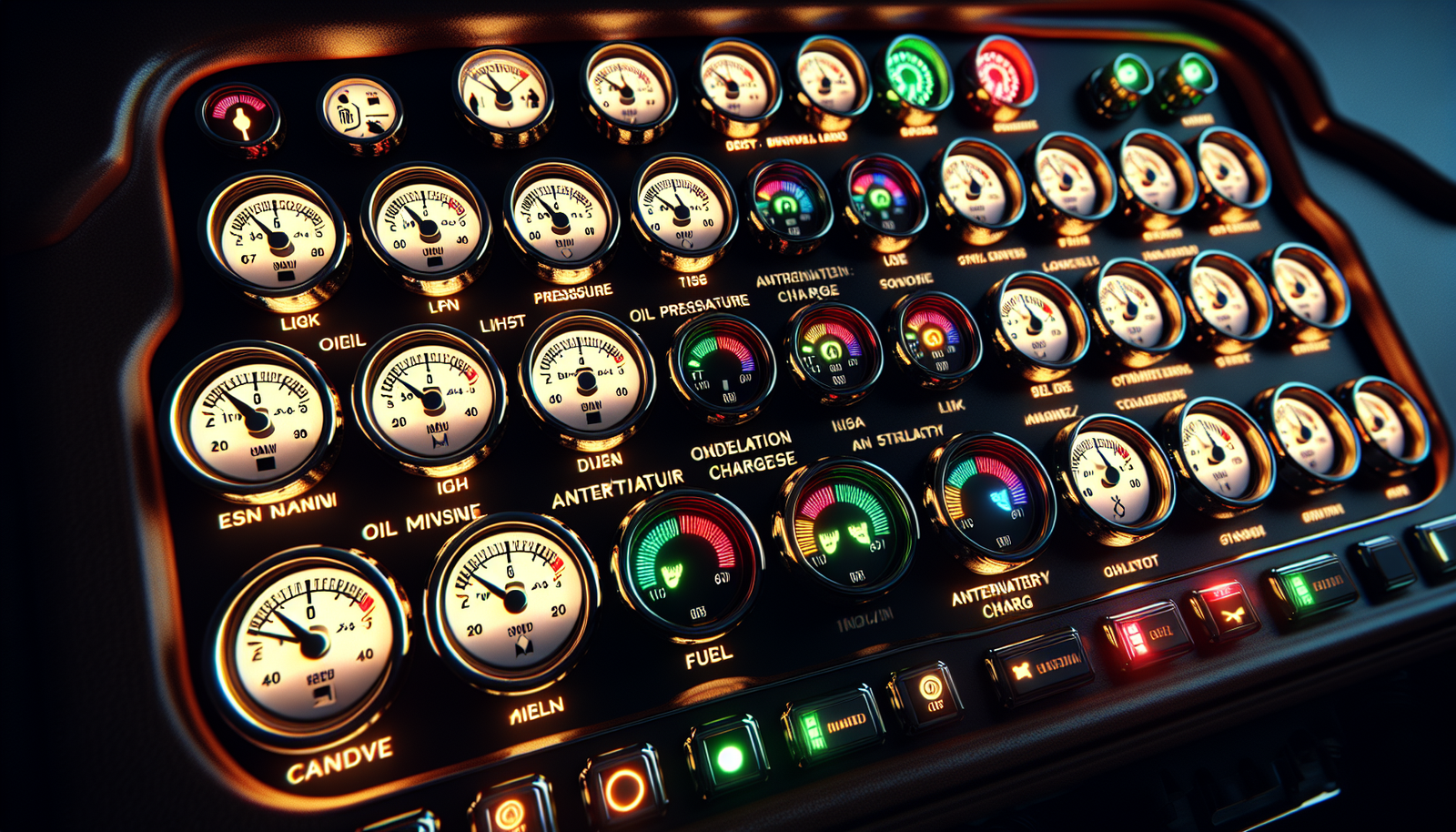Navigating the open seas can be exhilarating and adventurous, but it’s crucial to always have the knowledge that safeguards your journey. In “Understanding Boat Engine Warning Lights”, you’ll gain valuable insights into the importance of various boat engine warning lights. The purpose of these lights, what each color indicates, and the essential steps you need to take if a light comes on, are all areas you’ll become acquainted with. So, before your next sailing excursion, arm yourself with this newfound understanding to ensure a smooth and safe voyage.

Understanding the Importance of Boat Engine Warning Lights
As a boat owner, one of your primary responsibilities is maintaining your vessel in top condition. This includes understanding the importance of boat engine warning lights. These lights are not for display but serve functions that are crucial to your safety and the integrity of your vessel. Ignoring these lights could potentially put you in dangerous situations and cause costly repairs down the line.
Responsibility of Regular Maintenance Checks in Boating
Regular maintenance checks are imperative in boating. They entail a comprehensive inspection of all critical systems including the electrical system, engine cooling system, and the fuel system among others. When you conduct these checks, you are able to identify potential issues early before they escalate into major problems. It’s through these regular checks that you can notice if any of the warning lights are on and take the necessary actions.
How Warning Lights Contribute to Safety and Maintenance
Boat engine warning lights act as silent watchmen. They alert you when something goes wrong with your boat’s engine, such as low oil pressure, engine overheating, or a low battery charge. When you heed their warning, you’re able to address these issues promptly, keeping you safe on water and ensuring your boat doesn’t suffer prolonged damage.
The Link Between Warning Lights and Prolonged Engine Life
A well-maintained boat engine can serve you for many years. However, this requires you to promptly address any warnings that the engine gives off. By paying close attention to the warning lights and taking appropriate actions, you’re essentially prolonging your engine’s life span, saving you the cost and trouble of premature engine replacement.
The Role of the Boat’s Instrument Panel
Your boat’s instrument panel plays a critical role in monitoring and controlling your vessel’s operational status. It’s where you can find your warning lights.
Location and Presentation of Warning Lights
The exact location and presentation of the warning lights will depend on the type of your boat. However, they’re usually located on the dashboard or the instrument panel where they’re easily noticeable.
Understanding the Basic Functions of a Boat’s Instrument Panel
The instrument panel holds various gauges, indicators, and controllers that show you how well different aspects of your boat are performing. It displays data such as speed, fuel level, battery charge, engine temperature, and oil pressure.
The Connection of the Instrument Panel to the Boat’s Engine
The instrument panel is directly connected to the boat’s engine and other systems. Any anomalies in the boat’s operation result in respective warning lights coming on. For example, if the temperature of the engine exceeds a certain limit, the overheating warning light will illuminate.
Overview of Different Boat Engine Warning Lights
Warning lights vary depending on the type of boat and the manufacturer. Regardless of the differences, their purpose remains the same – to alert you of any problems that may affect the operation and safety of your boat.
Common Types of Warning Lights in Boats
Some common types of warning lights you can find on a boat include the overheat warning light, oil pressure warning light, alternator charge warning light, check engine light, battery warning light, and the water in fuel warning light.
Specific Examples of Warning Lights and Their Meanings
The overheat warning light alerts you when your engine’s temperature is too high. The oil pressure warning light comes on when there’s a drop in your engine’s oil pressure. The alternator charge warning light indicates a problem with your battery’s charging system. The check engine light often points to various issues with your engine’s performance.
Differences in Warning Light Systems Among Boat Manufacturers
Different boat manufacturers use different warning light systems. While some may use individual lights for different functions, others may use a singular check engine light that alerts you of various potential issues.

Recognizing the Overheat Warning Light
The overheat warning light is one of the most critical lights on your boat.
What Triggers the Overheat Warning Light
The overheat warning light comes on whenever a boat’s engine temperature exceeds its standard operating temperature. This could be due to various reasons like malfunctioning cooling components or blockages in the cooling system.
Possible Causes of Overheating in a Boat Engine
Boat engines overheat due to several reasons. These may include a broken water pump, low coolant levels, or a clogged or faulty radiator. Even a damaged heat exchanger or thermostat can contribute to engine overheating.
Immediate Actions to Take When the Overheat Light Comes On
As soon as the overheat warning light comes on, you should stop your vessel immediately and let the engine cool down. If safe and possible, inspect the engine for any visible issues and conduct a necessary repair or call a professional for assistance.
Understanding the Oil Pressure Warning Light
The oil pressure warning light is another important light that you have to monitor closely.
Understanding the Function of the Oil Pressure Warning Light
The oil pressure warning light comes on when there’s a significant drop in your engine’s oil pressure. This could be a sign of low oil levels or a problem with the oil pump. Waiting too long to resolve this issue may lead to severe engine damage.
Causes of Oil Pressure Problems
Oil pressure problems may arise due to low oil levels, oil contamination, or a malfunctioning oil pump. In some instances, it could be due to a faulty oil pressure gauge or sensor.
Possible Effects of Ignoring the Oil Pressure Warning Light
Ignoring the oil pressure warning light can be detrimental. Not addressing the underlying problem in time could lead to engine seizure, causing severe and often irreparable damage.
Addressing the Alternator Charge Warning Light
The alternator warning light is another critical light that requires your attention.
Understanding the Purpose of the Alternator Charge Warning Light
The purpose of the alternator warning light is to indicate an issue with your boat’s charging system. This could be a fault in the alternator, problems with the battery, or issues with the wiring.
Common reasons for the Alternator Warning Light to Illuminate
This warning light may illuminate due to a malfunctioning alternator, a worn-out serpentine belt, or a weak or dead battery. Inconsistencies in wiring and electrical connections could also trigger this light.
Repercussions of Disregarding the Alternator Warning Light
Ignoring the alternator warning light may lead to a drained battery, making it nearly impossible to start your boat’s engine. Over time, it may cause further damage to the electrical system and the engine.
Interpreting the Check Engine Warning Light
The check engine light is a universal warning light found in most boats and vehicles.
Basis for the Check Engine Warning Light
The check engine light illuminates when your boat’s computerized system identifies a problem that could affect the boat’s performance and emissions. This can be triggered by anything from a loose gas cap to a misfiring engine.
Common Issues Indicated by the Check Engine Light
Common issues associated with the check engine light can be faulty oxygen sensors, loose gas caps, bad spark plugs, or even more severe problems, like engine misfires or transmission issues.
Steps to Take When the Check Engine Light Comes On
If the check engine light comes on, you should identify the problem by using a diagnostic scan tool. If you cannot resolve the issue right away, you should get your boat to a professional as soon as possible.
Decoding the Battery Warning Light
The battery light is an important indicator of the condition of your boat’s electrical system.
Role and Significance of the Battery Warning Light
The battery warning light plays the role of indicating a failure in your boat’s charging system. This could mean a weak or dead battery, or an issue with your alternator which is not charging the battery correctly.
Typical Causes for the Battery Warning Light
Besides a failing battery, this light may illuminate due to problems with the alternator, worn-out drive belts, or issues with the wiring and connections in your boat’s charging system.
Effects of Neglecting the Battery Warning Light
Failure to address the defect leading to the illumination of the battery warning light may result in a dead battery, and hence an engine that won’t start. You might also experience dim lights, a weakening horn, and slowed or choppy windscreen wipers.
Examining the Water in Fuel Warning Light
The water in fuel warning light is one that indicates a problem with the quality of your fuel.
Explaining the Function of the Water in Fuel Warning Light
This light comes on when there is water detected in your boat’s fuel. This could be a result of condensation, a leak, or poor-quality fuel.
Reasons Behind the Presence of Water in Fuel
Water can get into your boat’s fuel tank due to various reasons such as a faulty fuel cap, cracked fuel lines, or a ruptured fuel tank. Even the temperature changes can cause condensation that results in water in your fuel tank.
Potential Damages of Ignoring the Water in Fuel Warning Light
Ignoring this light could lead to problems like fuel line freezing, bacterial growth, and engine misfires. In the worst case, it could cause severe damage to your engine, leading to costly repairs, or even engine replacement.
Routine Checks and Importance of Regular Maintenance
Just as regular health check-ups help keep you fit and healthy, regular boat maintenance and checks play a significant role in keeping your boat functioning efficiently. This includes paying attention to the warning lights.
Linking Regular Maintenance Checks to Warning Lights
Through routine checks, you can determine if your warning lights are functioning correctly, or if any of them are lit. This way, regular maintenance checks help you act swiftly on any warnings, preventing damage to your boat’s engines and other systems.
Best Practices in Routine Boat Maintenance
Regular maintenance of your boat includes checking and replacing engine oil and filters, inspecting and servicing the cooling system, ensuring the fuel system is clean, examining the belts and hoses, checking and cleaning the battery terminals among other tasks.
Impact of Regular Maintenance on Boat’s Lifespan
Routine maintenance tasks help prolong the lifespan of your boat. They ensure that your boat is operating at its peak efficiency, reduces the risk of unexpected breakdowns, and ultimately increases your boat’s resale value. By keeping the warning lights in check through these regular maintenance practices, you are ensuring better performance, safety, and extended lifespan for your boat.

